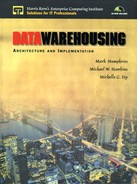This book is intended for Information Technology (IT) professionals who have been hearing about or have been tasked to evaluate, learn or implement data warehousing technologies.
Far from being just a passing fad, data warehousing technology has grown much in scale and reputation in the past few years, as evidenced by the increasing number of products, vendors, organizations, and yes, even books, devoted to the subject. Enterprises that have successfully implemented data warehouses find it strategic and often wonder how they ever managed to survive without it in the past.
As early as 1995, a Gartner Group survey of Fortune 500 IT managers found that 90 percent of all organizations had planned to implement data warehouses by 1998. Virtually all Top-100 US banks will actively use a data warehouse-based profitability application by 1998. Nearly 30 percent of companies that actively pursue this technology have created a permanent or semipermanent unit to plan, create, maintain, promote, and support the data warehouse.
If you are an IT professional who has been tasked with planning, managing, designing, implementing, supporting, or maintaining your organization's data warehouse, then this book is intended for you.
The first section introduces the Enterprise Architecture and Data Warehouse concepts, the basis of the reasons for writing this book.
The second section of this book focuses on three of the key People in any data warehousing initiative: the Project Sponsor, the CIO, and the Project Manager. This section is devoted to addressing the primary concerns of these individuals.
The third section presents a Process for planning and implementing a data warehouse and provides guidelines that will prove extremely helpful for both first-time and experienced warehouse developers.
The fourth section of this book focuses on the Technology aspect of data warehousing. It lends order to the dizzying array of technology components that you may use to build your data warehouse.
The fifth section of this book opens a window to the future of data warehousing.
This book also comes with a CD-ROM that contains two software products. Please refer to the readme.txt file on the CD-ROM for any last minute changes and updates.
The enclosed software products are:
R/olapXL®. . R/OLAPXL is a powerful query and reporting tool that allows users to draw data directly into Microsoft Excel spreadsheets from any dimensional data mart or data warehouse that resides on an ODBC-compliant database. Once the data are in Microsoft Excel, you are free to use any of Excel's standard features to analyze, report, or graph the retrieved data.
Warehouse Designer®. . Warehouse Designer is a tool that generates DDL statements for creating dimensional data warehouse or data mart tables. Users specify the required data structure through a GUI front-end. The tool generates statements to create primary keys, foreign keys, indexes, constraints, and table structures. It recognizes key dimensional modeling concepts such as fact and dimension tables, core and custom schemas, as well as base and aggregate schemas.
Also enclosed is a License Agreement that you must read and agree to before using any of the software provided on the disk. Manuals for both products are included as appendices in this book. The latest information on these products is available at the website of Intranet Business Systems, Inc. The URL is http://www.intranetsys.com.
